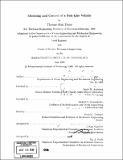| dc.contributor.advisor | Jamie M. Anderson and Michael S. Triantafyllou. | en_US |
| dc.contributor.author | Trapp, Thomas Alan, 1966- | en_US |
| dc.date.accessioned | 2010-01-07T20:44:27Z | |
| dc.date.available | 2010-01-07T20:44:27Z | |
| dc.date.copyright | 1998 | en_US |
| dc.date.issued | 1998 | en_US |
| dc.identifier.uri | http://hdl.handle.net/1721.1/50482 | |
| dc.description | Thesis (Nav.E.)--Massachusetts Institute of Technology, Dept. of Ocean Engineering; and, (M.S.)--Massachusetts Institute of Technology, Dept. of Mechanical Engineering, 1998. | en_US |
| dc.description | Includes bibliographical references (leaves 134-135). | en_US |
| dc.description.abstract | To understand the extremely complex hydrodynamics of fish swimming, it is desirable to build a mechanical prototype. This allows better cooperation of the "vehicle" under study than would be allowed with a live specimen. Draper Laboratory has undertaken the design and construction of a free-swimming fish robot called the Vorticity Control Unmanned Undersea Vehicle (VCUUV), patterned and scaled after a yellowfin tuna. The mechanical and electronic design of the VCUUV is versatile to allow ready variation of swimming parameters. Tests can be performed that will reveal the importance of each swimming pattern and how it contributes to the potentially superior efficiency of fish propulsion and how, ultimately, this mode of propulsion can be adapted to man-made vehicles. In this case of a mechanically complex and versatile robotic fish, a sophisticated control system algorithm is needed to ensure the motion closely approximates that of a live fish. Modeling and control of a hydrodynamic system is a difficult task, especially when the exact hydrodynamics have not yet been captured in a mathematical model. Based on some simplifying assumptions, a linear system model for the VCUUV is derived. Using state-space methods, a simulated controller is designed to govern this model. The ability of the controller to produce the desired system response is demonstrated, as well as robustness of the control algorithm in the presence of environmental disturbances and system model errors. | en_US |
| dc.description.statementofresponsibility | by Thomas Alan Trapp. | en_US |
| dc.format.extent | 135 leaves | en_US |
| dc.language.iso | eng | en_US |
| dc.publisher | Massachusetts Institute of Technology | en_US |
| dc.rights | M.I.T. theses are protected by
copyright. They may be viewed from this source for any purpose, but
reproduction or distribution in any format is prohibited without written
permission. See provided URL for inquiries about permission. | en_US |
| dc.rights.uri | http://dspace.mit.edu/handle/1721.1/7582 | en_US |
| dc.subject | Ocean Engineering | en_US |
| dc.subject | Mechanical Engineering | en_US |
| dc.title | Modeling and control of a fish-like vehicle | en_US |
| dc.type | Thesis | en_US |
| dc.description.degree | M.S. | en_US |
| dc.description.degree | Nav.E. | en_US |
| dc.contributor.department | Massachusetts Institute of Technology. Department of Ocean Engineering | en_US |
| dc.contributor.department | Massachusetts Institute of Technology. Department of Mechanical Engineering | en_US |
| dc.identifier.oclc | 42246741 | en_US |

